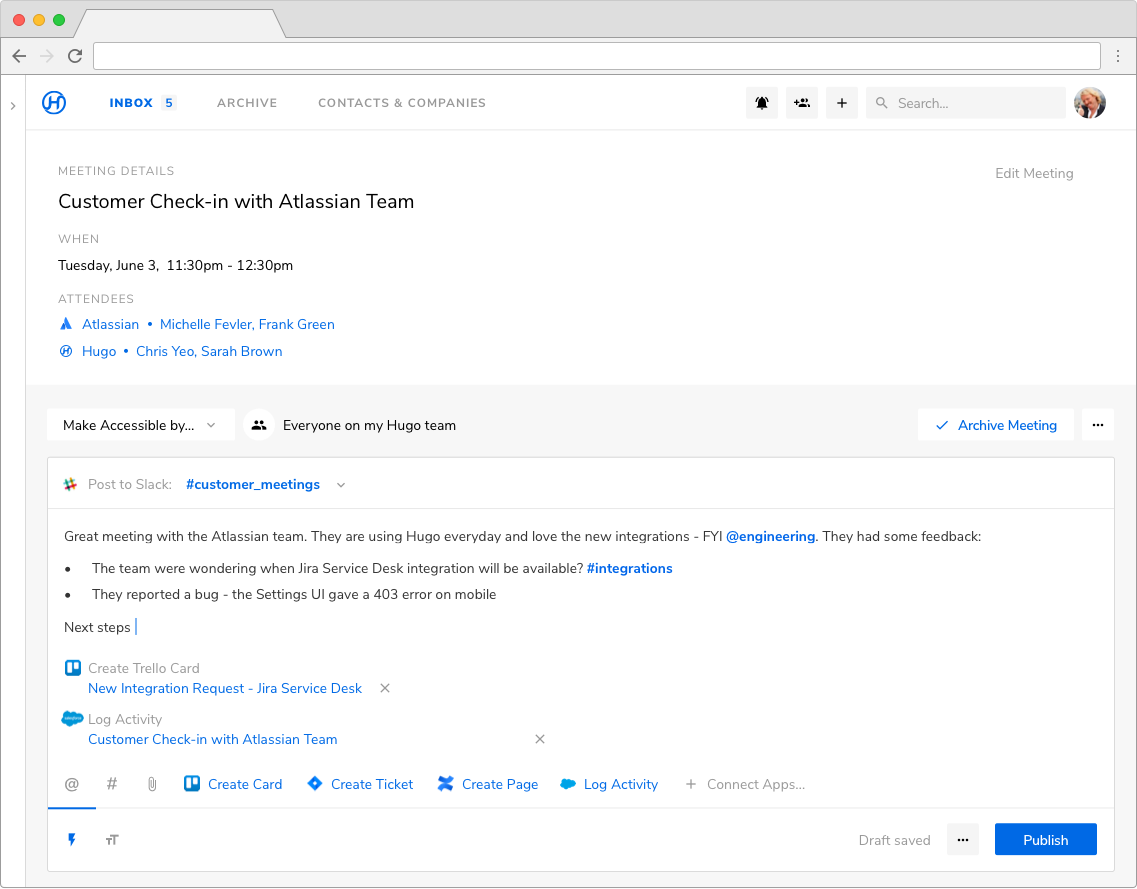Why and how to leverage customer insights to create a successful product

My Co-founder and I lead the team behind Hugo, a B2B SaaS company re-inventing how teams share and action customer meeting insights.
We’re first-time founders working on a problem that we personally grappled with in our prior lives. This makes us textbook startup founders, and not domain experts, so we spend a good part of our week reading, listening and asking for advice from those that have been there before. Some of what we like includes:
- Paul Graham and Sam Altman’s How to Start a Startup
- Clay Christensen’s Jobs to be Done methodology
- Eric Ries’ The Lean Startup
- Ben Horowitz’ The Hard Thing about Hard Things
To summarize key takeaways from these startup immortals on how to build product: religiously test and iterate. That means listening to your customers, testing ideas, sticking with what works and trying again. Obvious, right?
No matter how much I read or how many people I talk to, very few people talk about exactly how to handle customer insights. What should we do with this customer feedback? Exactly who should we share with? How quickly do we need to respond? We have quickly realized that approaching this in the right way can offer you and your product a huge unfair advantage.
This article shares two key approaches to handling customer insights that have paid dividends for us in building our product and business.
Spread Customer Insights Far and Wide
No book, podcast or word of advice ever told us that only sharing customer insights with product and design teams is a mistake. We discovered this by accident when we noticed a difference in the types of decisions made by the members of the team who had spent time with customers and those who hadn’t. This was exacerbated by the fact that we were an early stage startup and we relied on the whole team to make rapid decisions.
It is as important for almost every person in your business to hear from your customers, whether they’re in design, engineering, marketing or HR. Here's why:
1. Different Perspectives
One of the key differentiators for startups fighting conventional business is team diversity. Engineers think differently to designers and marketers think differently to accountants. Learning to leverage this diversity of perspectives and experience with respect to insights, provides your business with a further unfair advantage.
I can’t tell you how often an engineering perspective on a usability issue, or a marketer’s outlook on a new use case gives us something that would never have crossed the mind of our product or design teams. This alone is enough of a reason for us to socialize customer insights broadly across the business. It also assists in avoiding unconscious bias from those that were in the room and provides a fresh perspective from those who aren’t buried in the detail or directly involved in the design/specification of that piece of work.
2. Getting Buy-in
Everyone tries to hire the smartest team possible, but don't forget that smart people don't blindly follow orders. They seek to understand and provide input outside their direct area of responsibility.
Sharing customer insights empowers them to see the rationale and importance behind decisions which means there’s value in conveying the ‘why’ so that those delivering are onboard to produce a better result. Just the other day, we were able to build and ship a new integration in days, not weeks, simply because our engineering team understood the customer requirements for the integration, right from the customer’s mouth.
Show - don’t tell. Exposing your broader team directly to customer insights means that they hear the ‘why’ directly from the customer. They understand the context and requirements so that they are bought into the challenge, opportunity, or work that follows. We can credit our significant increase in team alignment to this benefit of sharing.
3. Straight to the Source
The product development process invariably leads to dilution of insights between feedback from a customer to when new updates get rolled out. This can have a material impact because some bias is natural when information passes through other humans. At Hugo, we’ve been guilty of recency bias and confirmation bias from time to time, as is easy to do when you’re receiving feedback about a product that you have built.
Whilst aggregating information is helpful to those consuming it, not enabling access to the original information means a loss of the language and insights that can only be read ‘between the lines’. I can name many examples where someone on our engineering team has identified a helpful takeaway that I didn’t pick up at a meeting.
Being able to develop an emotional connection to the feedback, having heard it ‘from the customer’ as opposed to just information provided by the product team can have a great effect on engagement. There’s nothing like hearing customer excitement on a product you designed or hearing critical feedback on a marketing campaign you were involved in.
You can easily do this by making the original insights available to the team, whether it by inviting them to some meetings, recording conversations, or using meeting note software to share notes.
At Hugo, to allow our entire team access ‘to the source’ of customer insights, we link back to the original meeting when specifying work or raising issues and also maintain links between meeting notes and the relevant tools that manage our process. Anyone on the team can click through from a JIRA or Trello ticket to the original meeting note from which the insight originated to get the full picture.

Share Customer Insights Fast
Hopefully, you agree with the opportunity that can be unlocked by sharing customer insights more widely in your business. The other factor is speed.
While many organizations do a great job at sharing customer insights on a monthly or infrequent basis, we’ve been able to unlock a competitive advantage for ourselves based on the speed at which this knowledge is shared. In our business, the average time from meeting insight to team sharing is measured in minutes and hours not weeks and months.
More interestingly, there has been an inverse correlation between the time it takes to share and action the insight and the corresponding customer’s receptiveness or willingness to pay. We can attribute this to a few things:
1. Impressed Customers = Valuable Customers
There’s plenty of research out there showing the relationship between good customer service and customer engagement and loyalty. Specifically, we have experienced that when we impress customers with our speed and responsiveness in creating action from their insights, that customer almost always becomes a loyal advocate for our product, whether that means increasing spend, use or referrals.

There’s no greater feeling for a customer when they report a bug and it’s fixed promptly, letting them know that their insight improved the product. Similarly, customers love when a new idea manifests in some design mockups a few days later. We now hold ourselves accountable based on the time elapsed from insight to action, recognizing the opportunity cost of delay.
2. Riding Momentum
An unfortunate fact in building a startup is that until you have a product that users truly love, the bargaining power is usually not in your favor. That means user interest peaks and wanes rapidly. In our early days, we often had a prospect excited with the value proposition with a high willingness to invest in the product which dissipated as they encountered a bug or missing feature.
In cases where we were able to action their insight (fixing the bug, building the feature or at least engaging the user in conversation as to how we were going to act and when), we were able to maintain the momentum of their interest. Conversely, where we took our time to react and respond, it became near impossible to re-enliven the lead.
Momentum is, therefore, another critical driver for us to capture, share and respond to insights fast.
3. The Importance of Currency
We’re proud of the pace at which we move. Very often product updates, bug fixes, and features are built and ready to deploy at the time we receive feedback, insights or complaints about an old part of the product. A more difficult scenario that also arises is where a customer insight is now incompatible with recent changes to the product, which requires you to either dismiss the insight or re-work the product changes, both costly for different reasons.
Optimizing for speed from insight to action has enabled us to minimize these types of issues. Ensuring that any customer insights are immediately routed to the team means that they have the full picture whilst working on their next challenge, affording them greater inputs into their process and less wasted work.
Implementing Wider, Faster Sharing of Insights
A takeaway to share customer insights wider than obvious and faster than you typically would is easier in 2018 than ever before. Today we have the benefit of real-time chat apps, dashboards, analytics and Chameleon, making it incredibly easy to communicate with your team and interface with the tools they use.
I recommend that you reflect on the touch points of the next customer insight that arises in a conversation, and how quickly it is actioned. You will no doubt see opportunities for optimization in terms of both coverage and pace.
Through, linking our source of customer insights, we’re able to turn what’s typically qualitative into quantitative data. Creating tickets in our backlog, items on our roadmap (or link insights to existing roadmap items) and bugs in our project management software directly from meeting notes allows us to prioritize feedback in our existing roadmap, alongside all the other ideas from the team. That means it fits in perfectly with our product management process, that our Head of Product looks at weekly.
This approach has inspired our thesis at Hugo - everyone takes meeting notes and simultaneously report how hard it is to share information and move fast. So why not create a tool that helps teams use their notes to do just that? For every insight that is captured when talking to a customer, partner or even internally, it should be super easy to share with those who weren't in the room and send those insights to the tools that we use to get our work done. You can learn more here.
About the Author:
This guest post is written by Darren Chait, Co-Founder at Hugo. Hugo is the team meeting note platform that keeps your team connected with what your customers are thinking and saying. Darren is an ex-Australian, now based in San Francisco, and is working hard with his team to unlock the power of meeting notes - destroying one information silo at a time.



